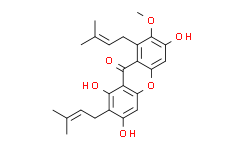| Cas No.: | 6147-11-1 |
| Chemical Name: | alpha-Mangostin |
| Synonyms: | 1,3,6-Trihydroxy-7-methoxy-2,8-bis(3-methylbut-2-en-1-yl)-9H-xanthen-9-one;1,3,6-Trihydroxy-7-methoxy-2,8-bis(3-methyl-2-butenyl)-9H-xanthen-9-one;1,3,6-TRIHYDROXY-7-METHOXY-2,8-DI(3-METHYL-2-BUTENYL)XANTHONE;Mangosteen;MANGOSTINE;Momordica Fruit P.E.;Fructus Monordicae extract;1,3,6-Trihydroxy-7-methoxy-2,8-bis(3,3-dimethylallyl)xanthone;Mangostin, α-;alpha-Mangostin;Mangostin;MANGOSTIN, ALPHA-(P)(REQUEST QUOTE) PrintBack;Mangostin, a-Mangostin;α-Mangostin;1,3,6-trihydroxy-7-methoxy-2,8-bis(3-methylbut-2-enyl)xanthen-9-one;[ "" ];NSC30552;NSC27593;U6RIV93RU1;GNRIZKKCNOBBMO-UHFFFAOYSA-N;1,3,6-trihydroxy-7-methoxy-2,8-diprenylxanthone;TNP00140;AK105375;1,3,6-Trihy |
| SMILES: | O1C2C([H])=C(C(C([H])([H])/C(/[H])=C(\C([H])([H])[H])/C([H])([H])[H])=C(C=2C(C2=C1C([H])=C(C(=C2C([H])([H])/C(/[H])=C(\C([H])([H])[H])/C([H])([H])[H])OC([H])([H])[H])O[H])=O)O[H])O[H] |
| Formula: | C24H26O6 |
| M.Wt: | 410.4596 |
| Purity: | >98% |
| Sotrage: | 4°C for 1 year, -20°C for more than 2 years |
| Description: | Alpha-mangostin is a dietary xanthone with broad biological activities, such as antioxidant, anti-allergic, antiviral, antibacterial, anti-inflammatory and anticancer effects. It is an inhibitor of mutant IDH1 (IDH1-R132H) with a Ki of 2.85 μM. |
| Target: | IC50: 2.85 μM (IDH1-R132H)[1] |
| In Vivo: | Alpha-mangostin reduces risk of liver fibrosis through the decrease in p53 expression as compared to the TAA_DMSO treatment. The serum levels of the liver enzymes AST and ALT after treatment with α-mangostin decrease as compared to DMSO alone[4]. |
| In Vitro: | Alpha-mangostin exhibits a selective inhibitory effect on IDH1-R132H, but not on IDH1. Alpha-mangostin competitively inhibits the binding of alpha-mangostin (α-KG) to IDH1-R132H. The structure–relationship study reveals that alpha-mangostin exhibits the strongest core inhibitor structure. Alpha-mangostin selectively promotes demethylation of 5-methylcytosine (5mC) and histone H3 trimethylated lysine residues in IDH1 (+/R132H) MCF10A cells[1]. Cell proliferation significantly decreases in a dose-dependent manner in the cells treated with alpha-mangostin. Alpha-mangostin also increases the levels of Bax (pro-apoptotic), cleaved caspase-3, cleaved caspase-9 and cleaved-poly(ADP-ribose) polymerase (PARP)[2]. Alpha-mangostin significantly inhibits light-induced degeneration of photoreceptors and 200 μM H2O2-induced apoptosis of RPE cells. 200 μM H2O2-induced generation of reactive oxygen species (ROS) and light-induced generation of malondialdehyde (MDA) are suppressed by alpha-mangostin[3]. |
| Cell Assay: | IDH1+/+ and IDH1 MCF10A cells are grown in DMEM/F-12 media, supplemented with 5% horse serum, 20 ng/mL EGF, 0.5 μg/mL hydrocortisone, 10 μg/mL insulin. IDH1+/+ and IDH1 MCF10A cells are seeded in 6 well plates. After an exposure to 5 μM alpha-mangostin. cells are collected after indicated times and the viable cell number is calculated, using hemacytometer counting[1]. |
| Animal Administration: | Rats: Male Wistar rats are divided into 3 groups and treated with intraperitoneal injections of TAA (200 mg/kg). One subgroup is left untreated whereas the other two are treated either with 100 mg/kg alpha-mangostin or vehicle alone (80% DMSO, 20% water), which are administered intraperitoneally 3 times per weekfor a total of4 weeks. The incidence offibrotic nodules on the liver and the serum levels of the liver enzymes aspartate transaminase (AST) and alanine transaminase (ALT) are measured[4]. |
| References: | [1]. Kim HJ, et al. Discovery of α-mangostin as a novel competitive inhibitor against mutant isocitrate dehydrogenase-1. Bioorg Med Chem Lett. 2015 Dec 1;25(23):5625-31. [2]. Lee HN, et al. Antitumor and apoptosis-inducing effects of α-mangostin extracted from the pericarp of the mangosteen fruit (Garcinia mangostana L.) in YD-15 tongue mucoepidermoid carcinoma cells. Int J Mol Med. 2016 Apr;37(4):939-48. |

 DC Chemicals' products qualify for U.S. tariff exemptions. We guarantee no price increases due to customs duties and maintain stable supply, continuing to deliver reliable research solutions to our American clients.
DC Chemicals' products qualify for U.S. tariff exemptions. We guarantee no price increases due to customs duties and maintain stable supply, continuing to deliver reliable research solutions to our American clients.





















